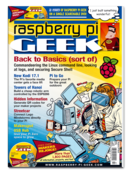Backing up photos with the Raspberry Pi (Part 2)
This project is the second in our series and follows on from the idea of setting up a data bank of your images to keep them safe. Simply connect your digital camera's memory card to the Pi using a USB adapter and it will automatically back up your photos (Figure 1). The status of the backup is signaled using the three LEDs. This sequel to our previous article still allows you to back up images easily while providing you with some extra options.
As promised in Part 1, there's now an updated version of the backup script. In addition, the backup should be accessible from a Windows machine. However, as the data is stored on a partition formatted for a Linux filesystem, attaching a drive to a Windows PC won't work. You can, however, find a workaround for this below. Finally, we set up a small web server so you can view your pictures whenever you want.
Better Backups
The backup script from Part 1 does the job but has a few flaws. For instance, when copying data from a memory card there's a chance it could accidentally overwrite files with identical names in the backup directory. The developer's GitHub page [1] now has an updated version of the copy_img script, imaginatively named copy_img2, which you'll find in the folder /files/usr/local/sbin.
[...]
Buy this article as PDF
Pages: 6
(incl. VAT)






